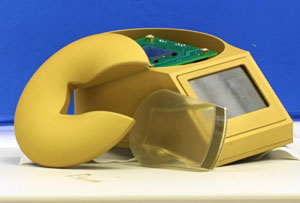| Posted: Oct 27, 2010 |
|
Sensors: A portable device for virus detection
|
|
(Nanowerk News) Recent infectious disease outbreaks, including the avian flu in 1997, the severe acute respiratory syndrome (SARS) in 2002–2003 and the H1N1 flu in 2009, are reminders of how vulnerable humans are to viruses. Our experience with pandemics has taught us that the early detection of infected individuals is crucial to preventing the spread of such contagions. A team led by Pavel Neuzil, a principal research scientist previously of the A*STAR Institute of Bioengineering and Nanotechnology (IBN), has developed a technology for the rapid detection of viruses that has now been adapted as a portable device for rapid virus detection in the field ("Rapid detection of viral RNA by a pocket-size real-time PCR system"). The technology could help save millions of lives, particularly in developing countries and remote areas.
|
|
Real-time (RT) reverse-transcription polymerase chain reaction (PCR) is currently the most sensitive and reliable technique for detecting viruses.
|
 |
| Fig. 1: Low-cost, portable virus detection could help prevent the spread of pandemic disease.
|
|
The technology involves making complementary DNA copies of viral RNA, multiplying the number of DNA copies and staining them with a fluorescent dye. The subtle differences in fluorescence intensity reflect the presence and quantity of viral RNA.
|
|
Conventional PCR devices are large, heavy and expensive. The two key components that make up the bulk of an RT-PCR device are the thermal cycler and the fluorescence detection system. The thermal cycler, consisting of a heater and sensor, controls the temperature of the sample in a cyclic manner; the fluorescence detection system consists of a metal halide light source or blue laser to excite the fluorescence and a photomultiplier tube to detect the excited light. The researchers miniaturized their PCR device by replacing the conventional aluminum block with a silicon-based micromachined 'lab-on-a-chip', the conventional light source with a light-emitting diode, and the photomultiplier tube with a photodiode.
|
|
Tests confirmed that the portable RT-PCR device (Fig. 1) could detect H5N1 viruses in as little as 35 minutes. Not only is the device reliable and fast, it is also cheap to manufacture—some 50 times cheaper than competing devices—and uses little power, making it particularly suitable for field and point-of-care applications. Its cost-effectiveness may even make it attractive as an educational tool.
|
|
"The detection device is already ready to use in its current form and is suitable for monitoring avian influenza outbreaks, especially in rural areas of developing countries," says Juergen Pipper, a member of the research team and a senior research scientist previously with the IBN. "We can also adjust the system so that it can detect other infectious diseases, including SARS."
|

